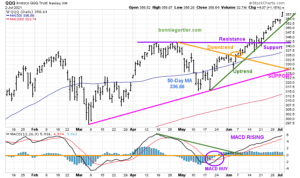Weakening Momentum and Price Action of the Russell 2000 (IWM) is Concerning
With uncertainty about the economy, the Federal Reserve cut interest rates for the first time since 2008 on July 31st. Historically, lower rates are positive for stocks. However, the news triggered selling by investors and increased volatility in August. The S&P 500 average daily change for the past 25 days is 0.88% and the Nasdaq Composite average daily change is 1.07%. Unfortunately, the technical picture is not as favorable as earlier in the year. The Cumulative Daily Advance-Decline Line of the New York Stock Exchange Index (NYSE) peaked on 7/30/2019. Since then market breadth has been negative. This month exhibited broad-based stock price weakness with three consecutive weeks of over -1800 net declining issues on the New York Stock Exchange Index (NYSE). This is not the type of tape action you normally experience to sustain a meaningful advance.
Defensive sectors such as Real Estate (IYR), Consumer Staples (XLP), and Utilities (XLU) continue to perform well. If the market were to begin a major decline, I would expect these sectors to hold up better than the broad market but not be unharmed. Most times when a market correction occurs, the decline will not end until the best performing sectors fall too. At present, these defensive sectors are strong, trading at new highs. Even though the major averages are not far from their new highs it remains worrisome to me that many sectors have not made new all-time highs. This raises a red flag with regard to the overall health of the market and how much longer it will continue moving higher before a significant decline begins.
Broad-based index ETF’s such as the Russell 2000 (IWM) and the S&P MidCap 400 (MDY) are still underperforming the S&P 500 (SPY) substantially below their all-time highs. As of the 8/20 close, the Russell 2000 (IWM) and the MidCap (MDY) is -14.00% and -8.5% below their August 2018 highs. Other ETFs below their all-time highs, are the Dow-Jones Transportation (IYT), -14.1% and the Emerging Markets ETF, -23.6%. If these sectors and the emerging markets continue to underperform, I would expect the market to remain volatile and be vulnerable to a potential serious market decline.
Where do we go from here?
Watch the Russell 2000 (IWM)
Figure: Weekly Russell 2000 (IWM) Price (Top) and 12-26-9 MACD (Bottom)

Figure: Weekly Russell 2000 (IWM) Price (Top) and 12-26-9 MACD (Bottom)
The top portion of the Russell 2000 (IWM)*** chart shows the weekly (intermediate-term) Russell 2000 (IWM) and its active price channel (purple line) with a 50-week moving average (pink line) that traders watch and use to define trends.
The Russell 2000 (IWM) has not confirmed its new all-time high made in the S&P 500 in July 2019. It began to weaken in October 2018 after falling below the 50-week Moving Average at 159.00 (blue circle). Selling accelerated after it fell below the middle channel making a low at 123.81 on 12/24. In January 2019, the IWM rose sharply as other indices, breaking the downtrend (orange line), then stalled on 2/25 at 159.50 after slightly penetrating the 50-week moving average. This pattern continued. On 5/19 IWM slightly penetrated the 50-week moving after reaching 161.00 (first red circle) and turned down. On 7/29, for the third time, IWM made a lower high at 159.23 (red circle on right) and then turned down away from its 50-week moving average.
The chart indicates signs of weakening momentum with the slope of the 50-week MA declining. Its price is well below the 50-week MA at 149.16. Until IWM shows strength and has a weekly close above the 50-week MA at 152.44, I am recommending caution. If IWM closes below the August 12 low at 144.79 it’s likely selling will intensify, and a test of the December lows could occur.
The lower portion of the chart is the MACD, a technical indicator that measures momentum. MACD is on a sell, falling below 0 with a bearish negative double top formation. For now, MACD remains on a sell and no signs yet imply that the downside momentum is complete and IWM is ready for a sustainable rise.
Just to Sum Up:
Our intermediate-term U.S. equity timing model remains on its 8/2 sell. The Russell 2000 (IWM) continues to underperform the S&P 500, and its trading below its 50-week moving average. The weekly MACD is on a sell with a double top showing a clear pattern of weakening momentum suggesting the short-term could be vulnerable. The first clue of more favorable market action would be if the IWM begins to outperform the S&P 500 (SPY) for several consecutive weeks. It would be a positive sign if and when IWM has a weekly close above the 50-week MA (152.44). However, to believe the IWM will not stall as it has, it needs to close above 161.00, the May high, clearly penetrating the 50-week Moving Average. On the other hand, a close below the August 12 low of 144.79 would suggest the stock market may begin a more serious decline.
I would love to hear from you. Please call me at 516-829-6444 or email at bgortler@signalert.com to share your thoughts or ask me any questions you might have.
***The iShares Russell 2000 Index ETF (IWM) is made up of companies with a market capitalization of between $300 million and $2 billion. The portfolio top 5 sector holdings as of 8/20/19 are Financials 25.38%, Health Care 16.73%, Industrials 15.70%, Technology 13.22%, and Consumer Cyclicals 12.31% (Source: //www.etf.com/IWM).
Sign up for a FREE 3 issue trial of
SYSTEMS AND FORECASTS Click here
******Article first published in Systems and Forecasts on August 21, 2019
Disclaimer: Although the information is made with a sincere effort for accuracy, it is not guaranteed that the information provided is a statement of fact. Nor can we guarantee the results of following any of the recommendations made herein. Readers are encouraged to meet with their own advisors to consider the suitability of investments for their own particular situations and for determination of their own risk levels. Past performance does not guarantee any future results.

If you like this article you will love my
Free EBook Grow Your Wealth and Well-Being Ebook













